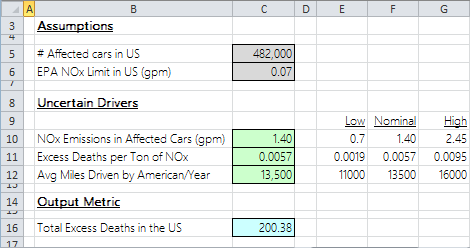As I’m sure you’ve heard, Volkswagen is in a whole lot of hot water after admitting they equipped their diesel cars with software that allowed them to cheat on EPA emissions tests. Affected car models were found to be spewing as much as 35 times the amount of nitrous oxide (NOx) permitted by the EPA in real world driving conditions. NOx is a pollutant that can cause a variety of adverse respiratory problems, particularly in susceptible populations. (https://www.epa.gov/no2-pollution)

While some of the specific numbers and details are still vague, it’s clear that the impact of the scandal on VW as a company is huge. They’ve halted car sales in the US, ousted their CEO, watched their stock price plummet and face potential fines in the billions – all great probabilistic modeling fodder. But what I found particularly compelling was an article and spreadsheet from Kevin Drum that estimated the number of deaths caused by VW’s deception:
http://www.motherjones.com/kevin-drum/2015/09/spreadsheet-day-how-many-people-did-vw-kill
In a few clicks I converted Kevin’s spreadsheet into one suitable for linking to a probabilistic DPL Model by assigning named ranges to the uncertain drivers and establishing an output metric. Within DPL I generated a tornado diagram and a risk profile to show the impact the range of the uncertain drivers has on the health those living in the US. See the Excel spreadsheet and DPL model:
Note: The model is just for the 482,000 corrupted cars sold in the US, a small fraction of the 11 million cars sold worldwide.
Additional Source:
http://www.nytimes.com/interactive/2015/09/22/business/international/vw-volkswagen-emissions-explainer.html